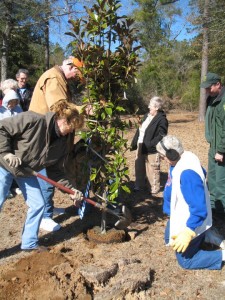The last several weeks have brought consistently cool weather to the Panhandle, with a few downright cold nights dipping well below freezing. Though winter isn’t officially here, that won’t happen until December 21st, grass mowing season is definitely over and, if you’re like me and didn’t cover your raised bed garden on those nippy nights, vegetable growing has also slowed significantly. So, what are us horticulturally minded folks with cold-weather cabin fever to do? It’s time to take advantage of sweat-free temperatures, break out the shovels and pruners, and get to work in the landscape!
The months of December through February are ideal times for planting new trees and shrubs. The reasons for this are simple. Days are short, rain tends to be plentiful, temperatures are cool, and plants are mostly dormant. While newly installed plants need water to become established regardless of when they are planted, demand for supplemental irrigation is significantly less in winter (one of our rainiest seasons) and the chances of a new planting dying from thirst is slim relative to warmer months. Also, planting in winter gives trees and shrubs several months of above ground dormancy to focus their resources below ground, recover from the shock of transitioning from a nursery container into your native soil, and produce valuable roots that will help it get through its first summer. Think about it. Would it be easier for you to start and finish a major outdoor project in July with one bottle of water to drink or in December with an ice chest full? Plants prefer the same!
Not only is winter perfect for planting, tis the season for pruning many species too, deciduous trees (those that lose their leaves in the fall) in particular! The first reason to prune these species in the winter is to give the plants several months to begin healing before growth resumes in spring and insect and disease pressure ramps up again. Many serious pests and diseases of trees are most active during warm, wet weather and all of them have easier access to attack trees through open wounds. Prune in winter to help avoid unwanted pest and disease infestations. Also, dormancy has conveniently knocked the leaves off deciduous species’ branches, allowing us a clear view of the tree’s crown and giving us the ability to make clear, clean, strategic pruning cuts. Proper pruning can help maintain a strong central leader that produces a stately, straight tree and remove dead and diseased branches that could cause problems in the future.
While planting in the winter is always ideal and we just outlined several reasons pruning now can be good, not all plants should be pruned when dormant. For instance, old-fashioned hydrangeas and azaleas that produce blooms from the previous season’s growth. Pruning these in the winter removes all the flower buds that would have bloomed the next summer and what’s the point of an azalea or hydrangea that doesn’t bloom? Also, many small trees and shrubs, like Crape Myrtle and Vitex, may never need pruning if you site them where they will have room to mature without encroaching on other plants or structures.
If you have any questions about planting trees and shrubs, what, when, and how to prune, or any other horticultural topic, please contact your local UF/IFAS Extension Office! Enjoy the weather and happy gardening!
- Mulch is a Must in Your Landscape - December 4, 2025
- Tis the Season – Why Winter is the Best Time to Plant Trees and Shrubs - November 26, 2025
- Feeling Blue (Ginger) This Fall - November 13, 2025

